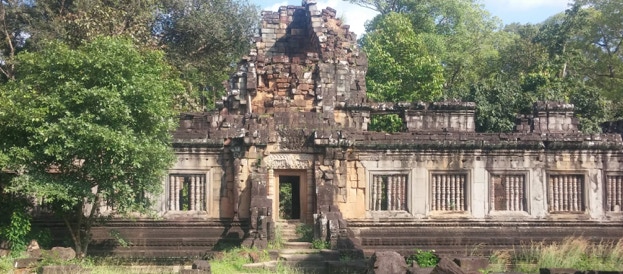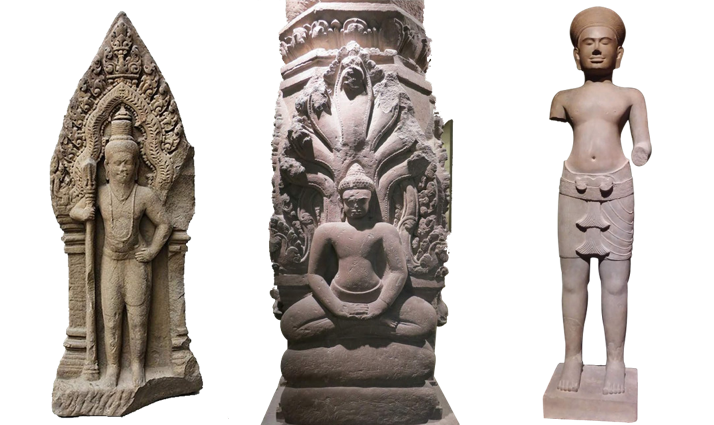THE KHLEANGS
(c.1000 - 1050)
NORTH KHLEANG (1000 - c.1010)

THE KHLEANGS
(c.1000 - 1050)
NORTH KHLEANG (1000 - c.1010)

The North Khleang, possibly undertaken during the disputed, truncated reign of Jayaviravarman (1002-1010,) is 40m long by 5m wide and earlier than the matching South Khleang which dates from his competitor Suryavarman I’s (1102-1149) rule, one of the surprisingly few buildings at Angkor for which he is credited. "Khleang" means "warehouse" in Khmer but it is a modern appellation; it is unlikely this elegant building would have had such a pedestrian use since only religious and ceremonial buildings were built of stone at Angkor; even the royal palace, on the other side of Angkor Thom's maidan or Victory Square, was built of perishable wood. The building may have been a treasury or a reception hall and rest house, like those as Prasat Thom and Banteay Srei. Since there is evidence of a courtyard behind this front range, it also resembles the "palaces" or accommodations for visiting dignitaries, found at Koh Ker, Phimai and Phnom Rung. A lintel is still visible and over it a pediment with a vase motif instead of a dramatic scene. The windows have lathe-turned balusters and chiseled pattika fillets and kantha recesses; only the cornice is embellished with vine motifs and beading. It is on account of this decorative restraint that the scantily documented architectural and sculptural style between 970 and 1050 was labeled "Khleang."
THE KHLEANG STYLE

KHLEANG STYLE SCULPTURE (c.970 - c.1050)
These three sculptures, all from the Musée Guimet in Paris illustrate the Khleang style which characterized Khmer sculpture from approximately 970 to 1050, the period between the "hyper-realism" of the carving at Banteay Srei and the informality of the Baphuon. The antefix, akroterion, finial or ornament at the left, crowning the corner of a tier of a shikhara, was found on the grounds of the royal precinct at Angkor Thom; it is an aediculum, a miniature portal with a torana arch or garland turned into a niche for a dvarapala or door guardian, next to the actual portal itself shaped after the shrine and its pyramidal shikara. The cusped garland, usually a stylized naga with rearing heads at either end, is wreathed with vertical leaves, also resembling flames; this antefix adds a level of imitation by shaping the ordinarily hemispheric pediment after one of its own blade-like leaves.
The lower portion of a square column or stambha, in the middle, is from Syr Yeay Yin, Phnom Srok, Banteay Meanchay, and ntended for pradakshina, ritual solar or clockwise circumambulation, with a different manifestation of Buddha on each of its four faces. Its predecessors would include the four lion pillars, representing the Four Noble Truths, erected by the first Buddhist emperor, Ashoka (c.250 B.C.E.), and the Mahayana "thousand Buddha pillars," though both these were round, the preferred shape of that religion. Pictured here is Sakyamuni, the historical Buddha, protected by the naga, Mukhalinda, meditating during a rainstorm in the sixth week after his enlightenment; on its other sides, in clockwise order, are Vajrapani, a fierce, protective deity, associated with Vajrayana or Tantric Buddhism; Prajnaparmita, the "Great Mother," a Mahayana deity symbolizing the wisdom of sunyata, the emptiness of all thought, (even her own wisdom and dharma, Buddha's teachings,) and, finally, Avalokitesvara, the bodhisattva of compassion, one of several candidates for the "face towers" at the Bayon (1181-1220.) This provincial monument dating from two centuries earlier with its references to the dhyani or tathagata, "wisdom Buddhas," evidences the practice in the Khmer Empire of Mahayana and probably Vajrayana schools of Buddhism long before the former became the state religion of Jayavarman VII (1181-1220) and his son, Indravarman II (1220-1243.)
The statue on the right lacking identifying attributes was discovered at Kampong Thom in Central Cambodia. It exemplifies the characteristic, rigid bearing of the Kleang style sculpture. The figure wears a distinctive Khmer sampot or breech cloth, tied in the fashion of the late 10th Century, the proper right side smooth with the left gathered, then hanging in a double "fishtail" sash.
57